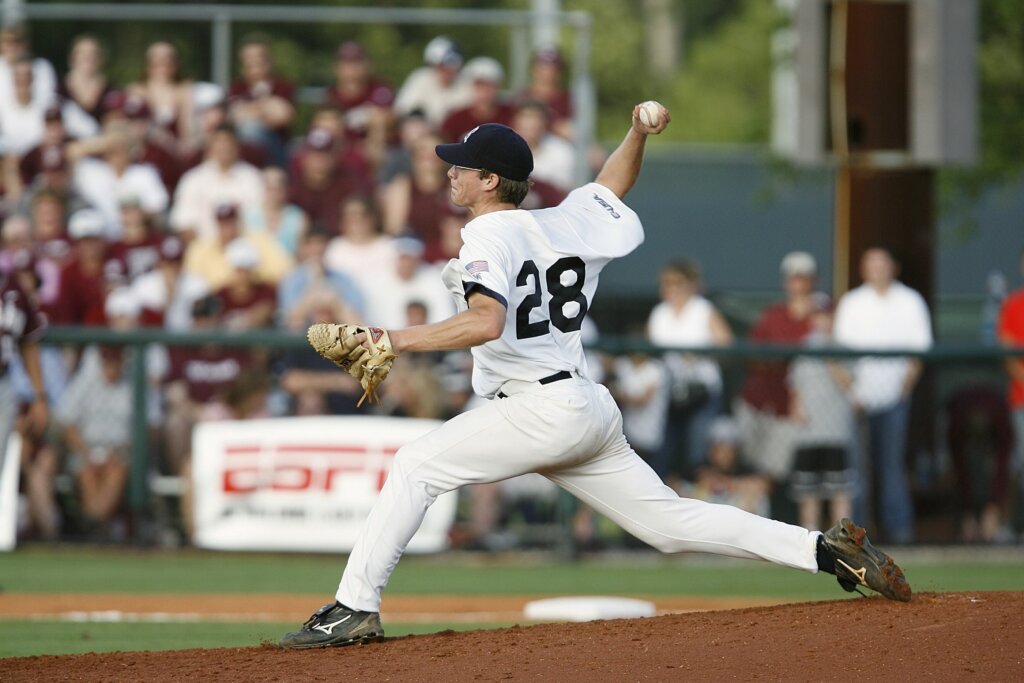
Earned Run Average, or ERA, stands out as a pivotal statistical metric in baseball, offering a quantitative assessment of a pitcher’s effectiveness.
It accomplishes this by determining the average number of earned runs a pitcher allows over the course of nine innings pitched.
The pitcher’s ERA is fundamental in the realm of major league baseball history analytics, acting as a reliable indicator of a pitcher’s skill in limiting opponents’ scoring, ultimately providing valuable insights into their overall defensive prowess on the mound. Below we’ll be exploring What Does ERA Mean in Baseball.
Understanding Earned Run Average
ERA is a nuanced metric in major league baseball that distinguishes itself by focusing exclusively on earned runs. Earned runs encompass those generated from hits, walks, or hit-by-pitches, excluding runs attributed to defensive errors.
This differentiation is pivotal as it furnishes a more precise portrayal of a pitcher’s performance, providing better insights into their control, strategic acumen, and the extent of defensive support they enjoy.
By zeroing in on earned runs, a pitcher’s ERA eliminates the impact of defensive errors on a pitcher’s statistical profile. This precision is particularly valuable when assessing a pitcher’s contribution to a game, as it emphasises their responsibility for runs directly attributed to their pitching performance.
Moreover, understanding ERA involves recognising its per-nine-inning nature, making it a standardised measure that facilitates fair comparisons between pitchers who may have faced different numbers of batters or pitched varying innings.
ERA Explained
ERA in baseball serves as a comprehensive metric in major league baseball that goes beyond a mere tally of runs conceded by a pitcher.
This standardised approach allows for effective comparisons across different pitchers and teams, offering a level playing field for assessment. It essentially quantifies a pitcher’s ability to prevent opponents from scoring, making it a valuable tool for coaches, analysts, and fans to evaluate and rank pitchers.
ERA, when explained, becomes a key benchmark for pitching performance, providing a numerical representation of a pitcher’s skill and effectiveness.
A lower ERA indicates a pitcher’s success in minimising earned runs, showcasing their ability to control the game and keep opponents off the scoreboard.
On the other hand, a higher ERA may suggest areas of improvement, such as struggles with control, susceptibility to hits, or challenges in adapting to different game situations.
Beyond being a historical record, ERA in baseball is forward-looking, allowing teams to make informed decisions about a pitcher’s potential impact in future games based on their past performance.
Insights into Pitching Effectiveness

This suggests a combination of strong control, effective pitch selection, and the capability to induce groundouts or strikeouts when needed. Such a pitcher becomes a reliable asset for a team, instilling confidence in their ability to keep the game competitive and within reach.
Conversely, a higher ERA may signal areas of concern, prompting further analysis into a pitcher’s performance. It could be an indicator of struggles with control, vulnerability to hits, or challenges in adapting to different batting lineups.
Context is essential in interpreting ERA, as external factors like defensive support and the overall competitiveness of the league must be considered. An improving or declining ERA can offer insights into a pitcher’s development, recovery from injury, or adjustments made in response to the evolving dynamics of the season.
Calculating ERA
The calculation of Earned Run Average involves a straightforward formula, yet it encapsulates the essence of a pitcher’s performance. To calculate ERA, one multiplies the total number of earned runs allowed by a pitcher by 9 (to represent a full nine-inning game) and then divides that result by the total number of innings pitched: ERA = (Total Earned Runs / Total Innings Pitched) × 9.
This per-nine-inning average provides a standardised measure that facilitates fair comparisons among pitchers who may have faced different numbers of batters or pitched varying innings. The multiplication by 9 is a crucial step, transforming the statistic into a rate that aligns with the traditional length of a baseball game.
The simplicity of the ERA calculation contributes to its widespread use and accessibility. However, beneath this simplicity lies a powerful tool for quantifying a pitcher’s ability to prevent earned runs. It distills a complex set of in-game dynamics into a single, easily interpretable figure. Understanding the mechanics of ERA calculation also allows for deeper analysis.
ERA as a Performance Benchmark
Fluctuations in the average ERA in baseball across seasons or eras can offer valuable insights into shifts in offensive and defensive strategies, rule changes, or even alterations in the characteristics of the baseball itself, influencing the game’s dynamics.
Understanding the historical context of ERA provides a broader perspective on the evolution of pitching in baseball. For example, a noticeable decrease in ERA across the league may suggest an era dominated by exceptional pitching talent or the implementation of rule changes favouring pitchers.
On the other hand, an increase in ERA could signal changes in offensive strategies, improvements in hitting technology, or adjustments to the dimensions of ballparks. Analysing changes in pitching standards through ERA also allows for comparisons between different eras of the game.
This comparative approach is essential in appreciating the accomplishments of pitchers across generations, considering the variations in playing conditions, equipment, and overall competitiveness. Moreover, changes in pitching standards can be indicative of broader trends in the sport.
Analysing Changes in Pitching Standards
A consistent, low ERA suggests that a pitcher can reliably deliver strong outings, limiting opponents’ earned runs and contributing to their team’s success.
These nuances provide valuable insights for coaches and teams in managing a pitcher’s workload and making strategic decisions during games. In short, evaluating a pitcher’s consistency through ERA provides a dynamic perspective on their performance.
It goes beyond a static measurement, offering a narrative of a pitcher’s ability to perform at a high level consistently, a quality highly coveted in the competitive landscape of baseball.
Other Important Pitching Metrics
In addition to ERA, several other pitching metrics are important in assessing a pitcher’s performance.
- WHIP (Walks plus Hits per Inning Pitched): WHIP is a comprehensive metric that considers both walks and hits allowed by a pitcher per inning pitched.
- Strikeout-to-Walk Ratio (K/BB): The K/BB ratio reflects a pitcher’s strikeouts compared to the number of walks they issue. A heightened K/BB ratio generally signals superior control and command, underscoring the pitcher’s capacity to dominate hitters while maintaining precision on the mound.
- Strikeout Percentage (K%): K% denotes the percentage of batters a pitcher strikes out in relation to the total batters faced. This metric serves as a pivotal indicator of a pitcher’s ability to generate strikeouts independently of defensive support, showcasing their knack for missing bats and securing outs.
- Ground Ball Rate (GB%): GB% signifies the percentage of batted balls hit on the ground.
- Left-on-Base Percentage (LOB%): this measures the percentage of baserunners that a pitcher strands on base without allowing them to score. A higher LOB% indicates a pitcher’s proficiency in working out of jams and preventing inherited runners from crossing home plate.
- Fielding Independent Pitching (FIP): FIP is an advanced metric that focuses on events a pitcher can control (home runs, strikeouts, and walks) while excluding factors influenced by defence. It provides an alternative perspective on a pitcher’s performance independent of fielding quality.
- xFIP (Expected Fielding Independent Pitching): xFIP adjusts FIP to account for the league-average home run-to-fly ball rate, offering a normalised view of a pitcher’s performance. It provides an estimate of a pitcher’s expected run prevention based on their underlying skills.
- Quality Start (QS): A quality start occurs when a starting pitcher completes at least six innings and allows three earned runs or fewer. While not a rate statistic like others, it is a traditional measure of a pitcher’s ability to keep their team in the game.
FAQs
What exactly does ERA represent in baseball and why is it important?
ERA, or Earned Run Average, in baseball symbolises the average count of earned runs a pitcher permits per nine innings thrown. Its significance lies in furnishing a standardised gauge of a pitcher’s effectiveness, facilitating comparisons across various players.
How is ERA calculated, and what does a high or low ERA indicate about a pitcher’s performance?
A diminished ERA reflects superior performance, indicating a reduced number of earned runs conceded, whereas an elevated ERA implies a pitcher is less proficient in thwarting opponents from scoring.
The calculation involves multiplying the pitcher’s total earned runs by 9 and subsequently dividing the result by the total innings pitched.
A heightened ERA signals a substantial yield of runs, underscoring defensive vulnerabilities, while a diminished ERA underscores a pitcher’s prowess in curtailing opponents’ scoring opportunities.
Are there any other metrics or factors that complement ERA when assessing a pitcher’s effectiveness?
ERA alone may not provide a complete picture, and other metrics like WHIP (Walks plus Hits per Inning Pitched) and advanced statistics like FIP (Fielding Independent Pitching) can complement ERA in evaluating a pitcher’s overall effectiveness.







